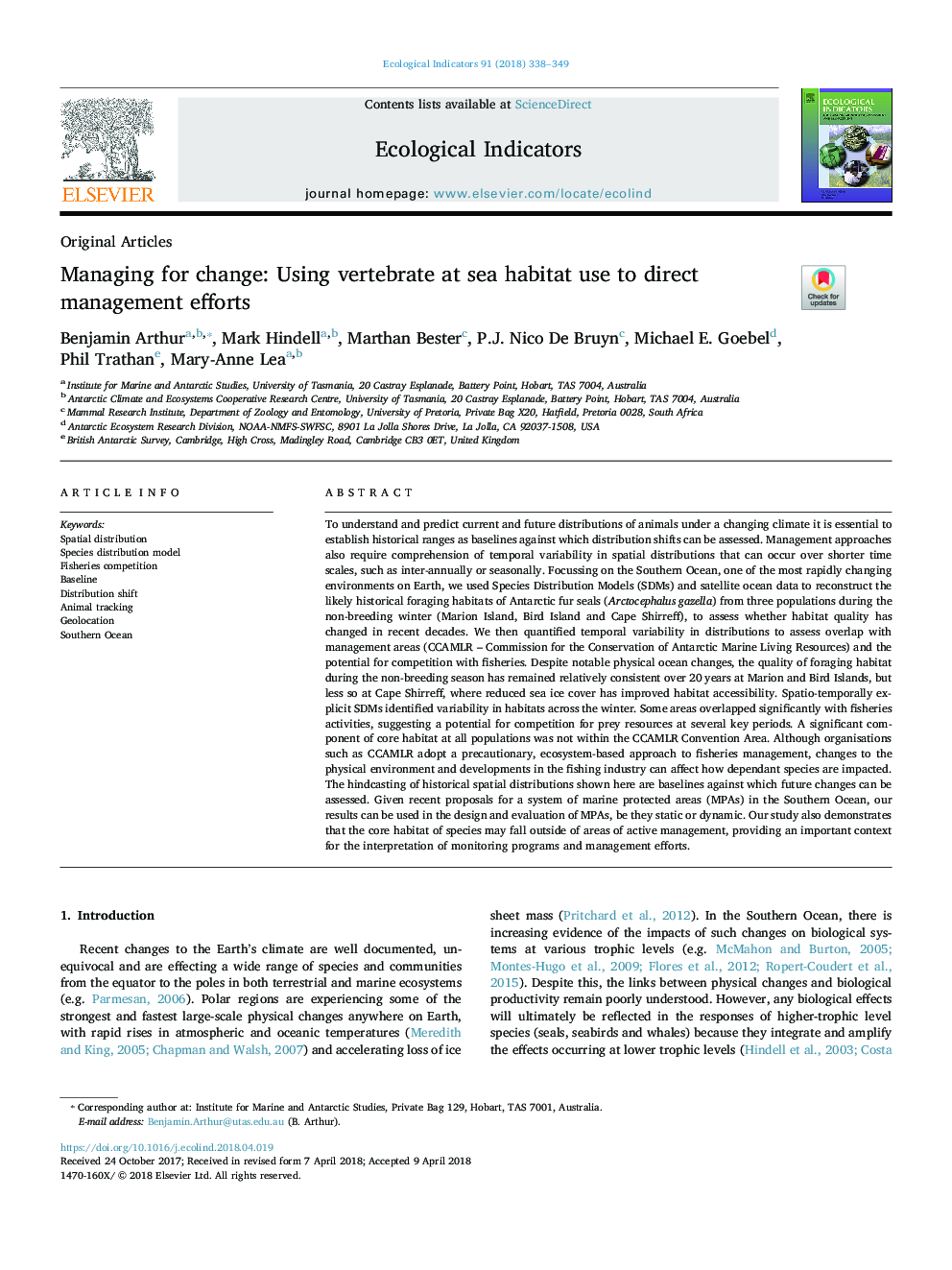| کد مقاله | کد نشریه | سال انتشار | مقاله انگلیسی | نسخه تمام متن |
|---|---|---|---|---|
| 8845334 | 1617111 | 2018 | 12 صفحه PDF | دانلود رایگان |
عنوان انگلیسی مقاله ISI
Managing for change: Using vertebrate at sea habitat use to direct management efforts
ترجمه فارسی عنوان
مدیریت برای تغییر: استفاده از مهره داران در استفاده از زیستگاه دریا جهت هدایت تلاش های مدیریت
دانلود مقاله + سفارش ترجمه
دانلود مقاله ISI انگلیسی
رایگان برای ایرانیان
کلمات کلیدی
توزیع فضایی، مدل توزیع گونه، رقابت شیلات، خط مقدم، تغییر توزیع، ردیابی حیوانات، موقعیت جغرافیایی، اقیانوس جنوبی،
موضوعات مرتبط
علوم زیستی و بیوفناوری
علوم کشاورزی و بیولوژیک
بوم شناسی، تکامل، رفتار و سامانه شناسی
چکیده انگلیسی
To understand and predict current and future distributions of animals under a changing climate it is essential to establish historical ranges as baselines against which distribution shifts can be assessed. Management approaches also require comprehension of temporal variability in spatial distributions that can occur over shorter time scales, such as inter-annually or seasonally. Focussing on the Southern Ocean, one of the most rapidly changing environments on Earth, we used Species Distribution Models (SDMs) and satellite ocean data to reconstruct the likely historical foraging habitats of Antarctic fur seals (Arctocephalus gazella) from three populations during the non-breeding winter (Marion Island, Bird Island and Cape Shirreff), to assess whether habitat quality has changed in recent decades. We then quantified temporal variability in distributions to assess overlap with management areas (CCAMLR - Commission for the Conservation of Antarctic Marine Living Resources) and the potential for competition with fisheries. Despite notable physical ocean changes, the quality of foraging habitat during the non-breeding season has remained relatively consistent over 20â¯years at Marion and Bird Islands, but less so at Cape Shirreff, where reduced sea ice cover has improved habitat accessibility. Spatio-temporally explicit SDMs identified variability in habitats across the winter. Some areas overlapped significantly with fisheries activities, suggesting a potential for competition for prey resources at several key periods. A significant component of core habitat at all populations was not within the CCAMLR Convention Area. Although organisations such as CCAMLR adopt a precautionary, ecosystem-based approach to fisheries management, changes to the physical environment and developments in the fishing industry can affect how dependant species are impacted. The hindcasting of historical spatial distributions shown here are baselines against which future changes can be assessed. Given recent proposals for a system of marine protected areas (MPAs) in the Southern Ocean, our results can be used in the design and evaluation of MPAs, be they static or dynamic. Our study also demonstrates that the core habitat of species may fall outside of areas of active management, providing an important context for the interpretation of monitoring programs and management efforts.
ناشر
Database: Elsevier - ScienceDirect (ساینس دایرکت)
Journal: Ecological Indicators - Volume 91, August 2018, Pages 338-349
Journal: Ecological Indicators - Volume 91, August 2018, Pages 338-349
نویسندگان
Benjamin Arthur, Mark Hindell, Marthan Bester, P.J. Nico De Bruyn, Michael E. Goebel, Phil Trathan, Mary-Anne Lea,
